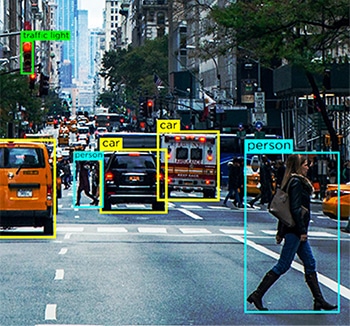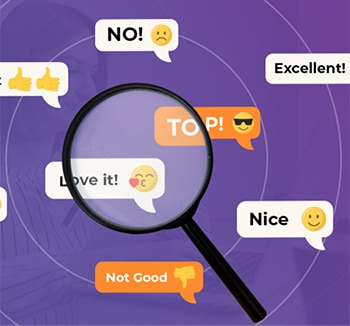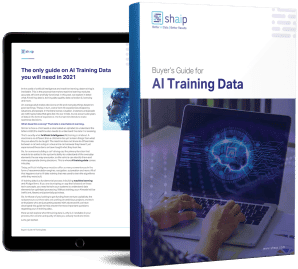What Is Training Data in Machine Learning:
Definition, Benefits, Challenges, Example & Datasets
The Ultimate Buyers Guide 2025
Introduction
In the world of artificial intelligence and machine learning, data training is inevitable. This is the process that makes machine learning modules accurate, efficient and fully functional. In this post, we explore in detail what AI training data is, training data quality, data collection & licensing and more.
It is estimated that on average adult makes decisions on life and everyday things based on past learning. These, in turn, come from life experiences shaped by situations and people. In the literal sense, situations, instances, and people are nothing but data that gets fed into our minds. As we accumulate years of data in the form of experience, the human mind tends to make seamless decisions.
What does this convey? That data is inevitable in learning.

Similar to how a child needs a label called an alphabet to understand the letters A, B, C, D a machine also needs to understand the data it is receiving.
That’s exactly what Artificial Intelligence (AI) training is all about. A machine is no different than a child who has yet to learn things from what they are about to be taught. The machine does not know to differentiate between a cat and a dog or a bus and a car because they haven’t yet experienced those items or been taught what they look like.
So, for someone building a self-driving car, the primary function that needs to be added is the system’s ability to understand all the everyday elements the car may encounter, so the vehicle can identify them and make appropriate driving decisions. This is where AI training data comes into play.
Today, artificial intelligence modules offer us many conveniences in the form of recommendation engines, navigation, automation, and more. All of that happens due to AI data training that was used to train the algorithms while they were built.
AI training data is a fundamental process in building machine learning and AI algorithms. If you are developing an app that is based on these tech concepts, you need to train your systems to understand data elements for optimized processing. Without training, your AI model will be inefficient, flawed and potentially pointless.
It is estimated that Data Scientists spend more than 80% of their time in Data Preparation & Enrichment in order to train ML models.
So, for those of you looking to get funding from venture capitalists, the solopreneurs out there who are working on ambitious projects, and tech enthusiasts who are just getting started with advanced AI, we have developed this guide to help answer the most important questions regarding your AI training data.
Here we will explore what AI training data is, why is it inevitable in your process, the volume and quality of data you actually need, and more.
What is AI Training Data?
It’s simple – data which is used to train a machine learning model is called training data. The anatomy of a training dataset involves labeled or annotated attributes, which allow models to detect and learn from patterns. Annotated data is critical in data training as it enables models to distinguish, compare, and correlate probabilities in the learning phase. Quality training data involves human-approved datasets, where data has gone through rigorous quality checks to ensure annotations are precise and correct. The clearer the annotation, the higher the data quality.
How Is Training Data Used In Machine Learning?
An AI/ML model is like an infant. It needs to be taught everything from scratch. Similar to how we teach an elementary school kid the parts of a human body, we have to lay out every aspect of a dataset through annotations. It is only through this information that a model picks up concepts, names, functionalities, and other attributes as defined by a human. This is crucial for both supervised and unsupervised learning models. The criticality increases as the use case becomes more niche.
Why Is AI Training Data Important?
The quality of AI training data directly translates to the quality of output of machine learning models. This correlation becomes more critical in sectors such as healthcare and automotive, where human lives are directly at stake. Besides, AI training data also influences the bias quotient of outputs.
For instance, a model that has been trained with just one class of sample set, say, from the same demographics or human persona, it may often lead to the machine assuming there exists no different types of probabilities. This gives rise to unfairness in output, which could eventually fetch companies legal and reputational consequences. To mitigate this, sourcing quality data and training models on this is highly recommended.
Example: How Self-Driving Cars Use AI Training Data to Navigate Safely
Autonomous cars use massive amounts of data from sensors like cameras, RADAR, and LIDAR. This data is useless if the car’s system can’t process it. For example, the car needs to recognize pedestrians, animals, and potholes to avoid accidents. It must be trained to understand these elements and make safe driving decisions.
Additionally, the car should understand spoken commands using Natural Language Processing (NLP). For instance, if asked to find nearby gas stations, it should interpret and respond accurately.
AI training is crucial not just for cars but for any AI system, like Netflix recommendations, which also rely on similar data processing to offer personalized suggestions.

Benefits of Training Models with Quality Datasets
Training models with high-quality datasets offers numerous advantages, such as:
- Improved performance of the model with respect to relevance, accuracy, and promptness
- Reduced training time
- Minimized over fitting and improved generalization
- Reduced bias
- Opportunity for brands to establish their presence and positive market sentiment and more
Challenges of AI Training Data
AI training is a sophisticated and massive undertaking, which involves its own set of challenges and bottlenecks. For starters, let’s look at some of the most common hurdles:
Lack of availability of right data
AI models can’t be trained on any available data. The data set fed into a model should align with business outcomes, vision, relevance to prompts, domain, subject matter expertise and more.
Considering the volume required for AI training, sourcing ideal data can be tricky. The complexity increases in sectors such as healthcare and finance, where data sensitivity is key.
Bias
Humans are innately biased and what we feed into a model is what the model processes and delivers as well. Combining this with the lack of quality data, models can develop
bias, leading to unfair and prejudiced outcomes.
Over fitting
This can be compared to a model’s auto-immune disease, where its own perfection acts as a bottleneck to tackle surprises and diversity in prompts. Such cases can lead to AI hallucinations,
where it does not know how to respond to prompts or questions it doesn’t align back to its training datasets.
Ethics and Explainability
One of the other complications with AI training is explainability. We can also refer to it as accountability, where we are unsure of how a model arrived at a particular response in terms of rationality. Conversations on making AI decision-making more transparent are happening currently and going forward, we will witness more protocols on XAI (Explainable AI).
Understanding the Difference between Training & Testing Data
The distinction between training and testing data is the same as the difference between preparation and examination.
| Aspect | Training Data | Testing Data |
|---|---|---|
| Purpose | Teaches a model to learn intended concepts | Validates how well the model has learned |
| Role | Preparation | Examination |
| Assessment | Not used for performance assessment | Critical for assessing performance (promptness, relevance, accuracy, bias) |
| Optimization | Helps in model training | Ensures model optimization and informs if more training data is needed |
| Stakeholder Decision-Making | Used to build the model | Used to decide on further training or adjustments based on model scores |
Use Cases
Smartphone Applications
It has become common for phone apps to be powered by AI. When a model is trained with solid AI training data, apps can better understand user preferences and behavior, predict actions, unlock phones, respond better to voice commands and more.
Retail
Shopping experiences of customers and engagements with leads are incredibly optimized through AI. From real-time discounts on cart abandonments to predictive selling, possibilities are limitless.
Healthcare
Healthcare probably benefits the most from AI and ML. From accompanying research in the field of oncology and aiding in drug discovery and clinical trials to detecting anomalies in medical imaging, AI models can be trained to perform niche functions.
Security
With the increasing rise of cyberattacks, AI can be used to mitigate sophisticated attacks through optimized network protection, anomaly detection, application security, fix codes with bugs and security loopholes, automate patch development and more.
Finance
AI helps the world of finance through advanced fraud detection methodologies, automating claims settlement, use of chatbots to conduct KYC formalities and more. BFSI companies are also leveraging AI to fortify their networks and systems through optimum cyber security measures.
Sales & Marketing
Understanding user behavior, advanced audience segmentation, online reputation management, and generation of copies for social media, social media campaign simulations and other benefits are prevalent for sales and marketing professionals.
How Much Data Is Required To Train ML Models?
They say there is no end to learning and this phrase is ideal in the AI training data spectrum. The more the data, the better the results. However, a response as vague as this is not enough to convince anyone who is looking to launch an AI-powered app. But the reality is that there is no general rule of thumb, a formula, an index or a measurement of the exact volume of data one needs to train their AI data sets.

A machine learning expert would comically reveal that a separate algorithm or module has to be built to deduce the volume of data required for a project. That’s sadly the reality as well.
Now, there is a reason why it is extremely difficult to put a cap on the volume of data required for AI training. This is because of the complexities involved in the training process itself. An AI module comprises several layers of interconnected and overlapping fragments that influence and complement each other’s processes.
For instance, let’s consider you are developing a simple app to recognize a coconut tree. From the outlook, it sounds rather simple, right? From an AI perspective, however, it is much more complex.
At the very start, the machine is empty. It does not know what a tree is in the first place let alone a tall, region-specific, tropical fruit-bearing tree. For that, the model needs to be trained on what a tree is, how to differentiate from other tall and slender objects that may appear in frame like streetlights or electric poles and then move on to teach it the nuances of a coconut tree. Once the machine learning module has learnt what a coconut tree is, one could safely assume it knows how to recognize one.
But only when you feed an image of a banyan tree, you would realize that the system has misidentified a banyan tree for a coconut tree. For a system, anything that is tall with clustered foliage is a coconut tree. To eliminate this, the system needs to now understand every single tree that is not a coconut tree to identify precisely. If this is the process for a simple unidirectional app with just one outcome, we can only imagine the complexities involved in apps that are developed for healthcare, finance and more.
Apart from this, what also influences the amount of data required for training includes aspects listed below:
- Training method, where the differences in data types (structured and unstructured) influence the need for volumes of data
- Data labeling or annotation techniques
- The way data is fed to a system
- Error tolerance quotient, which simply means the percentage of errors that is negligible in your niche or domain
Real-world Examples of Training Volumes
Though the amount of data you need to train your modules depends on your project and the other factors we discussed earlier, a little inspiration or reference would help get an extensive idea on data requirements.
The following are real-world examples of the amount of datasets used for AI training purposes by diverse companies and businesses.
- Facial recognition – a sample size of over 450,000 facial images
- Image annotation – a sample size of over 185,000 images with close to 650,000 annotated objects
- Facebook sentiment analysis – a sample size of over 9,000 comments and 62,000 posts
- Chatbot training – a sample size of over 200,000 questions with over 2 million answers
- Translation app – a sample size of over 300,000 audio or speech collection from non-native speakers
What if I don’t have enough data?
In the world of AI & ML, data training is inevitable. It is rightly said that there is no end to learning new things and this holds true when we talk about the AI training data spectrum. The more the data, the better the results. However, there are instances where the use case you are trying to resolve pertains to a niche category, and sourcing the right dataset in itself is a challenge. So in this scenario, if you do not have adequate data, the predictions from the ML model may not be accurate or may be biased. There are ways such as data augmentation and data markup that can help you overcome the shortcomings however the result may still not be accurate or reliable.




How do you improve Data Quality?
The quality of data is directly proportional to the quality of output. That’s why highly accurate models require high quality datasets for training. However, there is a catch. For a concept that is reliant on precision and accuracy, the concept of quality is often rather vague.
High-quality data sounds strong and credible but what does it actually mean?
What is quality in the first place?
Well, like the very data we feed into our systems, quality has a lot of factors and parameters associated with it as well. If you reach out to AI experts or machine learning veterans, they might share any permutation of high-quality data is anything that is –

- Uniform – data that is sourced from one particular source or uniformity in datasets that are sourced from multiple sources
- Comprehensive – data that covers all possible scenarios your system is intended to work on
- Consistent – every single byte of data is similar in nature
- Relevant – the data you source and feed is similar to your requirements and expected outcomes and
- Diverse – you have a combination of all types of data such as audio, video, image, text and more
Now that we understand what quality in data quality means, let’s quickly look at the different ways we could ensure quality data collection and generation.
1. Look out for structured and unstructured data. The former is easily understandable by machines because they have annotated elements and metadata. The latter, however, is still raw with no valuable information a system can make use of. This is where data annotation come in.
2. Eliminating bias is another way to ensure quality data as the system removes any prejudice from the system and delivers an objective result. Bias only skews your results and makes it futile.
3. Clean data extensively as this will invariably increase the quality of your outputs. Any data scientist would tell you that a major portion of their job role is to clean data. When you clean your data, you are removing duplicate, noise, missing values, structural errors etc.
What affects training data quality?
There are three main factors that can help you predict the level of quality you desire for your AI/ML Models. The 3 key factors are People, Process and Platform that can make or break your AI Project.

Platform: A complete human-in-the-loop proprietary platform is required to source, transcribe and annotate diverse datasets for successfully deploying the most demanding AI and ML initiatives. The platform is also responsible to manage workers, and maximize quality and throughput
People: To make AI think smarter takes people who are some of the smartest minds in the industry. In order to scale you need thousands of these professionals throughout the world to transcriber, label, and annotate all data types.
Process: Delivering gold-standard data that is consistent, complete, and accurate is complex work. But it’s what you will always need to deliver, so as to adhere to the highest quality standards as well as stringent and proven quality controls and checkpoints.
Where do you source AI Training Data from?
Unlike our previous section, we have a very precise insight here. For those of you looking to source data
or if you are in the process of video collection, image collection, text collection and more, there are three
primary avenues you can source your data from.
Let’s explore them individually.
Free Sources
Free sources are avenues that are involuntary repositories of massive volumes of data. It is data that is simply lying there on the surface for free. Some of the free resources include –

- Google datasets, where over 250 million sets of data were released in 2020
- Forums like Reddit, Quora and more, which are resourceful sources for data. Besides, data science and AI communities in these forums could also help you with particular data sets when reached out.
- Kaggle is another free source where you can find machine learning resources apart from free data sets.
- We have also listed free open datasets to get you started with training your AI models
While these avenues are free, what you would end up spending are time and effort. Data from free sources is all over the place and you have to put in hours of work into sourcing, cleaning and tailoring it to suit your needs.
One of the other important pointers to remember is that some of the data from free sources cannot be used for commercial purposes as well. It requires data licencing.
Data Scraping
Like the name suggests, data scraping is the process of mining data from multiple sources using appropriate tools. From websites, public portals, profiles, journals, documents and more, tools can scrape data you need and get them to your database seamlessly.
While this sounds like an ideal solution, data scraping is legal only when it comes to personal use. If you are a company looking to scrape data with commercial ambitions involved, it gets tricky and even illegal. That’s why you need a legal team to look into websites, compliance and conditions before you could scrape data you need.
External Vendors
As far as data collection for AI training data is concerned, outsourcing or reaching out to external vendors for datasets is the most ideal option. They take the responsibility of finding datasets for your requirements while you can focus on building your modules. This is specifically because of the following reasons –
- you don’t have to spend hours looking for avenues of data
- there is no efforts in terms of data cleansing and classification involved
- you get in hand quality data sets that precisely check off all the factors we discussed some time back
- you can get datasets that are tailored for your needs
- you could demand the volume of data you need for your project and more
- and the most important, they also ensure that their data collection and the data itself complies to local regulatory guidelines.
The only factor that could prove to be a shortcoming depending on your scale of operations is that outsourcing involves expenses. Again, what doesn’t involve expenses.
Shaip already is a leader in data collection services and has its own repository of healthcare data and speech/audio datasets that can be licensed for your ambitious AI projects.
Open Datasets – To use or not to use?

For instance, there is the Amazon product reviews dataset that features over 142 million user reviews from 1996 to 2014. For images, you have an excellent resource like Google Open Images, where you can source datasets from over 9 million pictures. Google also has a wing called Machine Perception that offers close to 2 million audio clips that are of ten seconds duration.
Despite the availability of these resources (and others), the important factor that is often overlooked is the conditions that come with their usage. They are public for sure but there is a thin line between breach and fair use. Each resource comes with its own condition and if you are exploring these options, we suggest caution. This is because in the pretext of preferring free avenues, you could end up incurring lawsuits and allied expenses.
The True Costs of AI Training Data
Only the money that you spend to procure the data or generate data in-house is not what you should consider. We must consider linear elements like time and efforts spent in developing AI systems and cost from a transactional perspective. fails to compliment the other.
Time Spent on Sourcing and Annotating Data
Factors like geography, market demographics, and competition within your niche hinder the availability of relevant datasets. The time spent manually searching for data is time-wasting in training your AI system. Once you manage to source your data, you will further delay training by spending time annotating the data so your machine can understand what it is being fed.
The Price of Collecting and Annotating Data
Overhead expenses (In-house data collectors, Annotators, Maintaining equipment, Tech infrastructure, Subscriptions to SaaS tools, Development of proprietary applications) are required to be calculate while sourcing AI data
The Cost of Bad Data
Bad data can cost your company team morale, your competitive edge, and other tangible consequences that go unnoticed. We define bad data as any dataset that is unclean, raw, irrelevant, outdated, inaccurate, or full of spelling errors. Bad data can spoil your AI model by introducing bias and corrupting your algorithms with skewed results.
Management Expenses
All costs involving the administration of your organization or enterprise, tangibles, and intangibles constitute management expenses which are quite often the most expensive.

How To Choose The Right AI Training Data Company And How Shaip Can Help You?
Choosing the right AI training data provider is a critical aspect in ensuring your AI model performs well in the market. Their role, understanding of your project, and contribution can be game-changing for your business. Some of the factors to consider in this process include:

- the understanding of the domain your AI model is to be built
- any similar projects they have previously worked on
- would they provide sample training data or agree to a pilot collaboration
- how do they handle data requirements at scale
- what are their quality assurance protocols
- are they open to being agile in operations
- how do they source ethical training datasets and more
Or, you can skip all this and directly get in touch with us at Shaip. We are one of the leading providers of premium-quality ethically sourced AI training data. Having been in the industry for years, we understand the nuances involved in sourcing datasets. Our dedicated project managers, team of quality assurance professionals, and AI experts will ensure a seamless and a transparent collaboration for your enterprise visions. Get in touch with us to further discuss the scope today.
Wrapping Up
That was everything on AI training data. From understanding what training data is to exploring free resources and benefits of data annotation outsourcing, we discussed them all. Once again, protocols and policies are still flaky in this spectrum and we always recommend you getting in touch with AI training data experts like us for your needs.
From sourcing, de-identifying to data annotation, we would assist you with all your needs so you can only work on building your platform. We understand the intricacies involved in data sourcing and labeling. That’s why we reiterate the fact that you could leave the difficult tasks to us and make use of our solutions.
Reach out to us for all your data annotation needs today.
Let’s Talk
Frequently Asked Questions (FAQ)
If you want to create intelligent systems, you need to feed in cleaned, curated, and actionable information for facilitating supervised learning. The labeled information is termed AI training data and comprises market metadata, ML algorithms, and anything that helps with decision making.
Every AI-powered machine has capabilities restricted by its historical stead. This means the machine can only predict the desired outcome if it has been trained previously with comparable data sets. Training data helps with supervised training with the volume directly proportional to the efficiency and accuracy of the AI models.
Disparate training datasets are necessary to train specific Machine Learning algorithms, for helping the AI-powered setups take important decisions with the contexts in mind. For instance, if you plan on adding Computer Vision functionality to a machine, the models need to be trained with annotated images and more market datasets. Similarly, for NLP prowess, large volumes of speech collection act as training data.
There is no upper limit to the volume of training data required to train a competent AI model. Larger the data volume better will be the model’s ability to identify and segregate elements, texts, and contexts.
While there is a lot of data available, not every chunk is suitable for training models. For an algorithm to work at its best, you would need comprehensive, consistent, and relevant data sets, which are uniformly extracted but still diverse enough to cover a wide range of scenarios. Regardless of the data, you plan on using, it is better to clean and annotate the same to improved learning.
If you have a particular AI model in mind but the training data is not quite enough, you must first remove outliers, pair in transfer and iterative learning setups, restrict functionalities, and make the setup open-source for the users to keep adding data for training the machine, progressively, in time. You can even follow approaches concerning data augmentation and transfer learning to make the most of restricted datasets.
Open datasets can always be used for gathering training data. However, if you seek exclusivity for training the models better you can rely on external vendors, free sources like Reddit, Kaggle, and more, and even Data Scraping for selectively mining insights from profiles, portals, and documents. Regardless of the approach, it is necessary to format, reduce, and clean the procured data before using.
